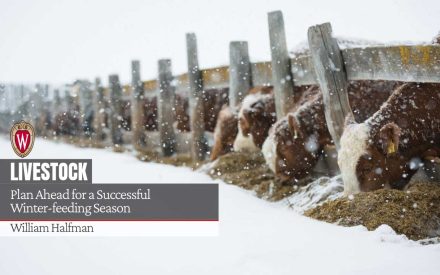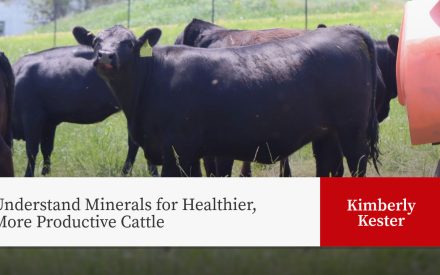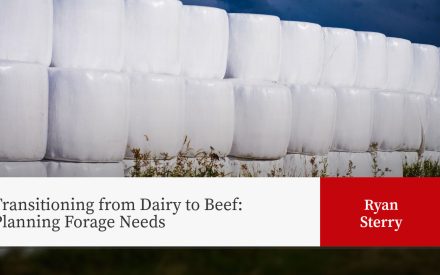Now is the time, before the snow flies, to take inventory of your farm’s forage supply and determine how well it meets the herd’s needs. Knowing your feed inventory and needs early allows you to purchase now, rather than wait to purchase during the winter when forages are usually priced higher. Or worse yet, trying to find feed when you are down to the last days’ worth of feed.
The process outlined in this article is intended to best allocate forage inventory to differing animal nutritional requirements based on animal age groups and their changing nutritional needs over the winter-feeding season. This process should help keep feed costs as economical as possible. This can be accomplished by figuring with a pencil and paper, or to make this process easier you can use the Forage Inventory and Needs calculator. This tool helps determine both the total harvested forage inventory and herd forage needs, it is not designed to balance rations. If you are not comfortable balancing rations, we strongly recommend working with a reputable nutritionist to formulate balanced ration(s) for your herd’s needs.
Step One: Inventory all forages available
This should include quantity and quality measurements. Separate the baled forage inventory into groups with similar quality (i.e. 1st cutting vs. 2nd, rained on vs. not, alfalfa grass vs. road ditch hay) rather than lumping everything together. The goal is to match your forage resources to your herd’s differing nutritional needs, while reducing the need to purchase feed. Use reasonable accuracy when determining weight of forages. The estimates and end results are only as accurate as the information you use.
For baled inventory quantity, do not base bale weights on book values, bale dimensions or manufacturers’ baler settings. Real world variations exist depending on the baler, baler operator and type of hay. Weigh a few bales (dry hay or wrapped baleage) to get a reasonable bale weight for each specific batch and cutting. There are a number of ways this can be done with on farm scales or taking a load to a scale at a feed mill or gravel pit. If weighing a truck or trailer load, make sure you have an accurate empty weight too. Then multiply this average weight by the number of bales in the batch to get a total weight for each baled forage type.
For ensiled feeds stored in bags, various silo types or piles, weighing some typical chopper box loads will provide a reasonable average weight. This means two trips over the scale: full – empty = weight of as-fed forage. Count loads placed into the storage structures to get a reasonable total weight estimate. It will be necessary to take into account fermentation and storage shrink if tracking weights of silage being put into storage to get a reasonable estimate of available feed. If it is not possible to weigh and count loads, dimensions of the storage structures (bags, tower silos, piles etc.) and either charts with weight estimates, or calculators included in the Forage Inventory and Needs Calculator can be used to estimate amount of forage in silage structures. Using the calculators with your actual measured density and moisture content will increase accuracy of the weight estimate in storage.
Forage test every forage source so balanced rations can be formulated. Prioritize forages for the production stages where they best fit.
Step Two: Determine daily forage requirements of each group of animals in the herd
In addition to prioritizing your various quality forage resources to the different nutritional needs of the herd during the winter-feeding season, this step also determines daily forage needs for animals throughout the winter-feeding season. When working with rations, it is important to keep in mind the cows’ changing needs during gestation and after calving, and the growing animals’ needs increasing as they get larger.
Each animal group (mature cows, young cows, replacement heifers, bulls, weaned calves, etc.) should have balanced rations formulated for them. Some groups may need more than one ration, for example, as the cow herd enters different stages of gestation, their nutritional requirements change. In some cases, rations may be as simple as determining which forage inventory group meets their needs, for a given period, along with what mineral supplement may be needed.
When determining daily forage requirements, it is also important to account for the types of feeders being used. On some farms, the bale size, feeders and herd size, will likely result in cattle being able to eat somewhat more than they need, but it might cost more to change feeding equipment or limit the amount delivered than let them eat a little extra. Limiting the time they have access to the feeder may be an option to manage their intake to help stretch forage supplies as long as they are able to consume what they need. Research at the University of Illinois observed that allowing cows access between 6 and 9 hours per day was adequate time for cattle to eat all they wanted, as long as all cattle could access the feed at the same time (Miller et.al. 2007). Some producers allow animals to have access to all the forages they can eat 24 hours a day. This still may not meet cattle needs, or it could greatly exceed them depending on forage quality and animal nutritional needs. Free-choice feeding may not be the most efficient use of feed resources.
Step Three: Determine total forage needs
Once the daily forage requirements per head for the various rations have been determined, multiply that by the number of head being fed the ration and number of days the ration is fed to get a total demand for each forage source. It is also important to factor in storage and feeding losses, referred to as shrink. The spreadsheet tool calculates shrink based on user input information. Some forage storage and feeding methods losses can be very high and there may be opportunities for producers to improve forage efficiency by improving storage and feeding losses. Following are some tables with examples of dry matter losses from storage and feeding.
Table 1. Effect of Storage Method on Dry Matter Loss of Big Round Bales (Saxe)
| Storage Method | Range of Dry Matter Loss (%) |
| Under roof | 2 – 10 |
| Plastic wrap, on ground | 4 – 7 |
| Bale sleeve, on ground | 4 – 8 |
| Covered, rock pad or elevated | 2 – 17 |
| Uncovered, rock pad or elevated | 3 – 46 |
| Uncovered, on ground, net wrap | 6 – 25 |
| Covered, on ground | 4 – 46 |
| Uncovered, on ground | 5 – 61 |
Table 2. Effect of Hay Feeding Loss by Feeder Type (Buskirk et.al.)
| Type of Feeder | Percent Hay Loss (%) |
| Ring without panel | 20 |
| Cradle feeder | 15 |
| Feeder wagon | 11.5 |
| Ring with panel | 6 |
| Cone feeder with panel | 3 |
Table 3. Effect of Storage Method on Silage Dry Matter Loss at Recommended Moistures (Holmes and Muck)
| Storage Type | Dry Matter Loss (%) |
| Top unloading tower | 11 – 19 |
| Oxygen limiting tower | 6 – 13 |
| Pile or bunker, covered | 18 – 34 |
| Bags | 9 – 14 |
Step 4: Compare inventory to needs to identify surpluses, shortages, or the need to change rations
Once forage inventory and needs have been determined, the next step is to determine if supplies are adequate, or if additional forages need to be harvested or purchased to make it through the winter. Adjust the rations to account for shortages of certain forages and surplus of others, or trade surplus forages for needed forages depending on prices and availability in each situation. Completing this task early will provide more options and greater flexibility for producers than waiting to compete with others who are feeding the last of their inventories.
It is time well spent to inventory your forages, plan rations and allocate your forage inventory to most efficiently and economically meet your herd’s needs. Download the calculator and take steps to meet the forage needs of your herd.
References
Buskirk D.D., A. J. Zanella, T. M. Harrigan, J. L. Van Lente, L. M. Gnagey, and M. J. Kaercher. “Large round bale feeder design affects hay utilization and beef cow behavior.” Journal of Animal Science 2003. 81:109–115
Holmes, B.J., R.E. Muck. “Preventing Silage Storage Losses.” UW Forage Fact Sheet (2000) Accessed 9-14-2020
Miller, A.J., D.B. Faulkner, T.C. Cunningham, J.M. Dahlquist. “Restricting Time of Access to Large Round Bales, of Hay Affects Hay Waste and Cow Performance.” The Professional Animal Scientist 23 (2007): 366-372
Saxe, C. “Big Bale Storage Losses; how different options stack up.” Focus on Forage Series (2007) Accessed: 9-14-2020
Reviewed by: Michael Baker, Beef Cattle Extension Specialist, Cornell University, and W. Travis Meteer, Extension Educator, Commercial Agriculture- Beef, University of Illinois.

 Plan Ahead for a Successful Winter-feeding Season
Plan Ahead for a Successful Winter-feeding Season Understand Minerals for Healthier, More Productive Cattle
Understand Minerals for Healthier, More Productive Cattle Transitioning from Dairy to Beef: Planning Forage Needs
Transitioning from Dairy to Beef: Planning Forage Needs Importance of Forage Growth Stages When Grazing Cattle
Importance of Forage Growth Stages When Grazing Cattle


